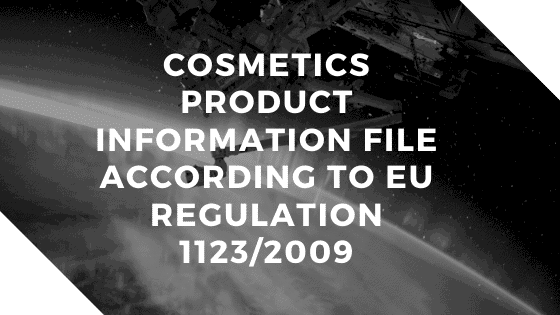Cosmetics Product Information File According to 1123 EU Regulation
Cosmetics Product Information File According to 1123 EU Regulation
If you’ve ever worked in the cosmetics industry or even just wondered what goes on behind the scenes of your favorite beauty products, you might have heard about something called the cosmetic product information file or CPIF. It’s not exactly a glamorous part of the beauty business, but it’s definitely one of the most important when it comes to ensuring that a product is safe, compliant with regulations, and market-ready in the European Union.
So, what exactly is the cosmetic product information file? Simply put, it’s a collection of documents that every cosmetic product sold in the EU must have. Think of it as a product’s “official record” or “safety passport.” The CPIF contains all the necessary information to prove that the product has been tested for safety, complies with 1123 EU Regulation, and meets the legal requirements for sale in the EU market.
Why does it matter? Well, without a properly maintained cosmetic product information file, a product can’t legally be sold in the EU. That means no matter how great the product is, if the CPIF is incomplete or missing key details, it won’t make it to the shelves.
But don’t worry, the cosmetic product information file isn’t something to be intimidated by. It’s essentially just a way to organize all the important safety data, manufacturing processes, and labeling info in one place, ensuring that the product is safe for consumers and compliant with the law. Let’s take a closer look at what goes into the CPIF and why it’s so crucial for any product you’re looking to sell in the EU.
The next section will break down exactly what’s included in the cosmetic product information file, so you’ll know exactly what to look for and what needs to be included to stay compliant. Stick around!
Essential Components of the Cosmetic Product Information File (CPIF)
Now that you have a basic understanding of what the cosmetic product information file (CPIF) is, let’s break down the essential components that make up this important document. Think of the CPIF as a blueprint for your cosmetic product, ensuring everything is in place to meet EU regulations and keep consumers safe.
1. Product Description
The cosmetic product information file starts with a solid product description. This includes basic details like the product name, the brand, and a clear description of its intended use. It’s where you explain what the product does—whether it’s a moisturizer, a lipstick, a face mask, or a shampoo. Essentially, it’s your product’s introduction to the regulatory world.
This section will also cover the ingredients, providing insight into the formulation, what’s inside the product, and how those ingredients are supposed to interact with the skin or hair. All of this helps regulatory bodies understand what the product is, what it’s meant to do, and how it should be used.
2. Cosmetic Safety Report (CPSR)
One of the most important components of the cosmetic product information file is the Cosmetic Safety Report (CPSR). This is where you show that your product has been thoroughly tested to ensure it’s safe for consumers. The CPSR is broken down into two parts: a safety assessment and a toxicological profile of each ingredient.
The safety assessment looks at potential risks like skin irritation or allergic reactions. It includes things like how the product will be used, the concentration of each ingredient, and how it might affect different skin types. The toxicological profile dives deeper into individual ingredients, evaluating their potential for harm and verifying that they comply with EU safety standards.
In other words, the CPSR is where you prove that your product has been rigorously tested and won’t harm anyone who uses it. It’s a huge part of the cosmetic product information file, and without it, your product can’t legally be sold in the EU.
3. Manufacturing Information
The cosmetic product information file also requires detailed manufacturing information. This section ensures that the product is made according to high standards and follows Good Manufacturing Practices (GMP). GMP guidelines are essential for ensuring that every batch of your product is consistent, safe, and high-quality.
You’ll need to include specifics about the manufacturing process—like the name and address of the manufacturing site, production methods, and quality control measures in place. By meeting GMP requirements, you show that your product was made in a controlled, safe environment, which is vital to ensure it’s not contaminated or poorly made.
4. Labeling and Claims
When it comes to cosmetics, the label is everything. Not only does it tell consumers how to use the product, but it also must meet regulatory requirements to make sure all necessary information is included. In the cosmetic product information file, you’ll need to provide a copy of the product’s label, along with any claims it makes, such as “dermatologically tested” or “hypoallergenic.”
The CPIF also includes an explanation of how those claims were tested and validated. For example, if you claim that your product is “non-comedogenic” (won’t clog pores), you must have evidence to back up that claim. This helps prevent misleading marketing and ensures that consumers can trust what they’re buying.
5. Stability and Compatibility Data
Another important part of the cosmetic product information file is stability and compatibility data. This includes testing that shows the product’s shelf life and how it holds up under various storage conditions (like heat or light). It also ensures that the packaging is compatible with the product and doesn’t affect its quality or safety over time.
Stability testing is essential because it gives consumers confidence that the product will work as expected throughout its shelf life. For example, a lotion that separates after a few months of use is not something a consumer would want to purchase.
So, there you have it! These are the core components of the cosmetic product information file. The CPIF is essentially a detailed safety and quality checklist for every cosmetic product sold in the EU. It’s designed to make sure that all aspects of a product—its ingredients, safety, manufacturing process, and labeling—are properly documented and meet EU standards.
By keeping all of this information up-to-date and in one place, you’re not only staying compliant with the law but also ensuring that your product is safe and trustworthy for consumers. In the next section, we’ll take a deeper look at why having a well-organized cosmetic product information file is so crucial for ensuring compliance and market access. Stay tuned!
Why is the Cosmetic Product Information File Crucial for Compliance?
By now, we’ve learned what goes into the cosmetic product information file (CPIF), but why is it so important? Well, the CPIF is not just a collection of paperwork—it’s a critical part of ensuring that your cosmetic product is safe, legal, and able to be sold in the EU market. Let’s break down why maintaining a proper cosmetic product information file is crucial for compliance with EU regulations and why it should be a priority for anyone in the cosmetics business.
The Legal Requirement for the Cosmetic Product Information File
First off, the cosmetic product information file is not optional—it’s required by EU Regulation 1223/2009. If you want your cosmetic product to be legally marketed in the EU, you must have a CPIF that includes all the necessary information about the product, from safety reports to manufacturing details. Without it, your product could be removed from the market, or worse, you could face legal penalties.
In short, having a cosmetic product information file that’s complete and up-to-date is essential for ensuring your product’s legal standing. If you don’t comply with the regulation, you won’t just be risking fines or penalties; you could also damage your brand’s reputation and lose consumer trust.
Consumer Safety and Transparency
The CPIF plays a huge role in consumer safety. It ensures that products on the market are tested for safety, contain only approved ingredients, and have clear, truthful labeling. The cosmetic product information file acts as proof that your product has undergone safety assessments and meets all the required standards for quality and safety.
Think of it this way: consumers want to know that the products they’re using are safe, especially when it comes to things like skincare, makeup, and hair care. By keeping a cosmetic product information file, you’re providing transparency and reassurance that your product has been rigorously tested and complies with the strictest EU safety standards. This is something your customers will appreciate, as it builds trust and encourages repeat purchases.
Ensuring Smooth Market Access
Another reason why the cosmetic product information file is crucial for compliance is that it’s directly tied to market access. If your product is going to be sold in the EU, it has to be in compliance with EU Regulation 1223/2009. This regulation ensures that cosmetic products are safe for consumers and legally acceptable for sale in the EU.
Without a cosmetic product information file, your product can’t be marketed in the EU. It’s that simple. The CPIF is the key that unlocks access to the European market, and any missing documentation or incomplete file could prevent your product from being approved for sale.
The CPIF also plays a role in preventing unsafe or non-compliant products from reaching the market. If your product doesn’t meet the standards outlined in the regulation, it could be flagged by authorities during inspections, and you may face product recalls or market bans. By ensuring that your cosmetic product information file is complete and compliant, you’re avoiding unnecessary obstacles that could delay or stop your product from reaching consumers.
Protecting Your Brand and Reputation
In addition to legal and regulatory reasons, maintaining a solid cosmetic product information file also protects your brand and reputation. A well-organized CPIF demonstrates your commitment to consumer safety, quality, and transparency. It shows that you care about providing high-quality, safe products and that you are serious about following the law.
On the flip side, if your products are found to be non-compliant, you could end up with product recalls, fines, and a tarnished brand image. Consumers today are more informed and conscientious than ever. They want to know that the brands they support are ethical and transparent. By maintaining a cosmetic product information file, you’re showing that your brand is one they can trust, which in turn boosts your credibility and helps build long-term customer loyalty.
In summary, the cosmetic product information file is crucial for ensuring compliance with EU regulations, promoting consumer safety, and protecting your brand’s reputation. It acts as a key piece of documentation that proves your product is safe, legally compliant, and ready for market. Whether you’re just starting out or are already established, maintaining an up-to-date CPIF is an essential part of staying on the right side of the law and building trust with your customers.
In the next section, we’ll take a closer look at how to create and maintain your cosmetic product information file, so you can be sure your product is always ready for compliance checks and market access. Stay tuned!
How to Create and Maintain the Cosmetic Product Information File (CPIF)
Alright, now that we know why the cosmetic product information file (CPIF) is so important, let’s dive into the nitty-gritty of how to actually create and maintain one. Whether you’re launching a brand-new product or ensuring an existing one is compliant, having a properly organized CPIF is essential. But don’t worry! It doesn’t have to be overwhelming. With a bit of planning and attention to detail, you’ll have your CPIF up to standard in no time.
Step 1: Gather All the Required Documentation
The first step in creating your cosmetic product information file is gathering all the necessary documents that prove your product meets EU Regulation 1223/2009. Think of this as compiling a set of evidence to show that your product is safe, well-made, and properly tested. The key documents that should be included in your CPIF are:
- Product Description: This should include basic details like the name of the product, the intended use, and the type of cosmetic (e.g., skincare, makeup, hair care). You’ll also need to describe the ingredients and how they contribute to the product’s function.
- Cosmetic Safety Report (CPSR): This is one of the most critical pieces of the CPIF. The CPSR contains the results of safety assessments, including toxicological profiles of each ingredient, risk assessments, and details about how the product will be used. If any testing was done, it should be clearly outlined here.
- Manufacturing Information: Include details about where and how the product is made. This section will confirm that Good Manufacturing Practices (GMP) are being followed and that the product is produced in a safe, controlled environment.
- Labeling Information: Provide a copy of the product’s label, including all ingredients, claims, warnings, and usage instructions. If you’re making specific claims (e.g., “dermatologically tested”), you need to include the evidence supporting those claims.
- Stability and Compatibility Data: This shows that the product has been tested for stability, ensuring it won’t break down or degrade over time, and that the packaging is compatible with the product.
Step 2: Organize the Information Clearly
Now that you’ve gathered all the necessary documentation, it’s time to organize everything in a clear and accessible way. The cosmetic product information file should be structured in a way that allows anyone (whether it’s a regulatory body, an inspector, or even a colleague) to easily understand the product’s safety, manufacturing, and compliance status.
A good CPIF should include the following sections, neatly divided for easy reference:
- Introduction: Basic details about the product and its purpose.
- Safety Data: The CPSR, including the toxicological information and safety assessment.
- Manufacturing Process: Evidence that GMP standards are followed.
- Product Labeling: A copy of the product label and any claims made.
- Testing and Stability Data: Any additional stability tests and compatibility data.
It’s also important to ensure that the documents are easily updated. If you change an ingredient, update the label, or make adjustments to your manufacturing process, you should update the CPIF right away. This will help you avoid any compliance issues down the road.
Step 3: Assign a Responsible Person (RP)
In the EU, every cosmetic product must have a Responsible Person (RP) who is legally accountable for ensuring that the product meets all regulatory requirements. This person or team is responsible for maintaining the cosmetic product information file and ensuring that it is kept up to date.
The Responsible Person plays a key role in ensuring that the CPIF contains all the required documents, and they are also the person who would communicate with authorities if there were any issues with the product or if a recall was necessary. If you’re running a small brand, you might be the Responsible Person yourself, but larger companies may have someone dedicated to this role.
Step 4: Regularly Update the CPIF
The beauty industry is constantly changing, with new ingredients, formulations, and safety data coming to light all the time. That’s why it’s important to keep your cosmetic product information file regularly updated. Here are some of the things you’ll need to update in your CPIF:
- New Safety Data: If new testing or studies are done on ingredients or products, you need to update the CPIF to reflect this.
- Formulation Changes: If you tweak the formula of your product, update the CPIF with information on the new ingredients and their safety assessments.
- Regulatory Changes: The EU regulations can evolve, so always stay up to date on any changes to the rules and make sure your CPIF is in compliance with the latest standards.
Step 5: Store the CPIF Properly
Lastly, once you’ve created and updated your cosmetic product information file, make sure it’s stored properly. You’ll want to keep it in a secure location where it’s easily accessible in case it’s needed for inspection or compliance checks.
Most companies opt for electronic storage of the CPIF, but ensure that the file is organized, well-protected, and regularly backed up. The CPIF must be kept for at least 10 years after the last batch of the product is placed on the market, so it’s important that you can easily retrieve it if needed.
In summary, creating and maintaining a cosmetic product information file is a process that involves careful documentation, regular updates, and a clear organization system. By following the steps above, you can ensure that your products comply with EU regulations and are always ready for market. Having a well-organized CPIF also demonstrates that your brand is committed to safety, transparency, and consumer protection, helping you build trust with both regulators and your customers.
In the next section, we’ll look at some common mistakes companies make when compiling their cosmetic product information file, and how you can avoid them. Stay tuned!
Common Mistakes in Cosmetic Product Information Files
When it comes to creating and maintaining a cosmetic product information file (CPIF), it’s easy to overlook some key details or make mistakes, especially if you’re new to the process. However, small errors can lead to big issues when it comes to compliance, and in some cases, they could prevent your product from being sold in the EU market. So, let’s take a look at some of the most common mistakes brands make when putting together their CPIF, and how you can avoid them to ensure your products stay compliant.
1. Missing or Incomplete Safety Data
One of the most critical parts of your cosmetic product information file is the Cosmetic Safety Report (CPSR). It’s the document that proves your product is safe for consumers to use. But, believe it or not, this is one of the most common areas where mistakes happen. Some brands fail to include the necessary toxicological assessments, risk evaluations, or up-to-date safety data for every ingredient used in the product.
To avoid this mistake, make sure you have a full and comprehensive CPSR that includes:
- Toxicological profiles for each ingredient
- Safety assessments that account for things like skin irritation, allergic reactions, and other potential risks
- Product usage data—this tells regulators how the product will be applied and whether it might pose any risks to users based on its formulation and intended use.
Also, remember that safety data must be updated if the formulation changes or if new scientific research emerges. Keeping the CPSR current is key to maintaining compliance.
2. Forgetting to Update the Cosmetic Product Information File
We know it can be tempting to “set and forget” once your cosmetic product information file is complete, but that can be a costly mistake. Regulations evolve, new safety data comes out, and ingredient lists change over time. Your CPIF needs to be a living document that’s updated regularly to stay compliant.
One of the biggest mistakes brands make is failing to update the CPIF when they make changes to the product formula, packaging, or even the claims they make on the label. If you change an ingredient or your product goes through a reformulation, the safety data and the information in your CPIF need to reflect those changes.
To stay on top of this, designate a person or team to regularly review and update the CPIF. Make sure any new information is added as soon as it’s available.
3. Inaccurate or Missing Label Information
Your product’s label is one of the most visible aspects of your cosmetic product information file, but it’s also one of the easiest places to make mistakes. Whether it’s a missing allergen warning, incorrect ingredient list, or a claim that can’t be backed up, inaccurate labeling is a serious compliance issue under EU Regulation 1223/2009.
In the CPIF, you’ll need to include a copy of the product label and verify that all required information is clearly visible and accurate. This includes:
- Ingredient list (in INCI format)
- Claims (like “dermatologically tested” or “hypoallergenic”), which must be supported by the appropriate testing
- Warnings (such as “keep out of reach of children” or “do not use on broken skin”)
When making claims, make sure they are substantiated with appropriate documentation—claims without evidence could lead to fines or recalls. Also, don’t forget to include any batch or expiration numbers that need to be listed as part of the labeling requirements.
4. Failing to Keep the Cosmetic Product Information File Accessible
Another common mistake is not keeping the cosmetic product information file easily accessible. EU Regulation 1223/2009 requires that the CPIF be readily available for inspection by authorities, and you need to keep it on file for at least 10 years after the last product batch is placed on the market.
Some brands store the CPIF in a disorganized way or in a place that makes it difficult to retrieve when needed. This can be a huge issue during inspections or if a regulatory body requests to see the file.
Make sure that the CPIF is stored securely but in an easily accessible location—whether that’s a digital file that’s organized and backed up or a physical file stored in a safe, designated space.
5. Overlooking the Responsible Person (RP)
The cosmetic product information file is not just a set of documents—it must be managed by a Responsible Person (RP), who is accountable for ensuring that the product complies with EU Regulation 1223/2009. The RP should be listed in your CPIF, and their contact information should be included for easy access by authorities.
A common mistake is not clearly identifying or assigning the RP or failing to update the CPIF when there’s a change in responsibility. Without a designated Responsible Person, your CPIF could be considered incomplete or non-compliant.
To avoid this, make sure the RP is clearly identified in the CPIF, and if the RP changes, update the file right away. The RP must be available to answer any questions from regulatory bodies and ensure that all documentation is up to date.
To sum up, the cosmetic product information file is a crucial document that ensures your products meet EU regulations and are safe for consumers. Avoiding common mistakes, such as missing safety data, inaccurate labels, or failing to update the file, will help you stay compliant and ensure your product is always ready for the market.
In the next section, we’ll talk about the consequences of not maintaining a proper cosmetic product information file and why it’s so important to get it right from the start. Stay tuned!
The Consequences of Not Maintaining a Cosmetic Product Information File
At this point, we’ve walked through how to create and maintain your cosmetic product information file (CPIF), and the importance of keeping it up to date. But what happens if you don’t follow these rules or fail to maintain your CPIF properly? Unfortunately, the consequences can be pretty serious, ranging from legal penalties to damage to your brand’s reputation. Let’s take a closer look at the potential risks you face if your cosmetic product information file isn’t up to standard.
Product Recalls and Market Bans
One of the most immediate consequences of not maintaining a complete and accurate cosmetic product information file is the potential for a product recall. If the authorities discover that your product doesn’t meet EU Regulation 1223/2009 requirements—whether it’s because the CPIF is incomplete, the safety data is missing, or the product has been tested incorrectly—your product could be taken off the market.
A recall is not only costly and time-consuming, but it can also lead to significant brand damage. Consumers are unlikely to trust a brand that has had to recall a product, especially if it involves safety or health concerns. Plus, once a product is pulled from the market, you’ll have to fix the issue, resubmit all the required documentation, and potentially face further scrutiny from regulators.
Even worse, if your product is found to be seriously non-compliant, it could face a market ban. This means you won’t be able to sell that product in the EU at all—an incredibly expensive and damaging outcome for any brand.
Legal Penalties and Fines
Failing to maintain the cosmetic product information file can also result in significant legal penalties. EU regulations are strict, and non-compliance can lead to fines or even legal action. The fines for not having a complete CPIF can vary depending on the severity of the violation, but they can quickly add up and become a financial burden for your business.
In some cases, if you’re found to have misrepresented or made unsubstantiated claims on your product label (or failed to provide required documentation), legal authorities could impose heavy fines. This could be especially damaging for smaller businesses, as it can divert resources from growth and product development into paying fines and dealing with legal issues.
Damage to Brand Reputation
One of the most lasting consequences of failing to maintain a proper cosmetic product information file is the potential damage to your brand reputation. In today’s world, transparency and trust are key to building customer loyalty. If your product is pulled from the market due to non-compliance, or if your brand faces legal consequences, consumers may feel that they can no longer trust your products.
A damaged reputation can be hard to repair. Consumers expect beauty brands to be ethical, transparent, and reliable, and a failure to meet EU animal testing regulations or properly maintain your CPIF can undermine that trust. It can take a lot of time, effort, and marketing to rebuild that trust, and in some cases, the damage may be irreversible.
Additionally, word of mouth (whether on social media, reviews, or blogs) can amplify the damage. If a product recall or market ban gets publicized, it’s often hard to control the narrative. Customers might assume your whole brand is unreliable, even if the issues were isolated to just one product.
Loss of Market Access
In the EU, compliance with EU Regulation 1223/2009 is a requirement for selling your cosmetic products. Without a valid cosmetic product information file, you won’t be able to sell your products in the EU market. This loss of market access can be particularly detrimental if your products are already established or if you’ve spent a significant amount of money getting them to market.
The EU is one of the largest and most competitive beauty markets in the world. If your products are unable to enter this market, you could miss out on a huge opportunity. That’s why keeping your CPIF up-to-date and compliant is essential if you want to continue selling and expanding your brand within the EU.
Complicated Inspections and Audits
Another consequence of neglecting your cosmetic product information file is that you may face additional inspections or audits. Regulatory bodies can request to see your CPIF at any time, and if it’s not in order, you could face delays, fines, or product seizures. These audits are thorough, and having incomplete or inaccurate information will only delay the process of getting your product back on track.
If your brand is repeatedly flagged for non-compliance, you may even face more frequent inspections. This is not only stressful but also costly, as it requires dedicating more time and resources to meet regulatory requirements rather than focusing on your business’s growth.
In conclusion, the consequences of not maintaining a cosmetic product information file are serious and far-reaching. From product recalls and fines to long-lasting damage to your reputation and the potential loss of market access, the risks are high. Keeping your CPIF updated and compliant with EU Regulation 1223/2009 is essential for maintaining a successful, legally compliant, and trustworthy brand.
In the next section, we’ll look at how the cosmetic product information file fits into the global context, particularly how it influences international markets and how companies can prepare for future regulations. Stay tuned!
The Global Impact of the Cosmetic Product Information File
Now that we’ve covered why the cosmetic product information file (CPIF) is so crucial for the EU market, let’s take a step back and look at the bigger picture. The CPIF doesn’t just affect the cosmetics industry within the European Union; it has a growing influence on the global market as well. So, how does this piece of paperwork fit into the worldwide landscape, and why should it matter to companies looking to expand internationally?
Influence on International Markets
As more countries adopt similar regulations to the EU, the cosmetic product information file is becoming a key piece of compliance documentation for cosmetics sold around the world. Many countries outside the EU are taking notice of the CPIF and incorporating similar standards into their own regulations.
For instance, countries like South Korea, Brazil, and even the US have been gradually implementing stricter cosmetic safety regulations, drawing inspiration from the EU’s cosmetic product information file requirements. This means that international brands that want to market their products across multiple regions are finding that the CPIF is becoming an increasingly universal standard.
By maintaining a CPIF, your brand is not only ensuring compliance with EU laws but also preparing for smoother market entry into other regions. You might not be selling directly in those countries yet, but being ready for global regulations can give you a competitive edge when you do decide to expand.
Consistency and Transparency Across Borders
One of the main reasons why the cosmetic product information file is gaining traction globally is that it provides consistency and transparency. Regulatory bodies around the world are increasingly prioritizing consumer safety, and the CPIF offers a comprehensive, standardized way of showing that a product has been thoroughly tested and is safe for use.
For companies looking to expand into international markets, maintaining a cosmetic product information file ensures that there’s a single, reliable document that can be used to meet various regulatory requirements. Instead of creating different sets of documents for different regions, the CPIF can often be adjusted slightly to meet the specific requirements of each market, making the process of international expansion smoother and more cost-effective.
Easing Export Challenges
If your goal is to export your products to countries outside the EU, having an up-to-date cosmetic product information file is a must. Many nations require documentation that proves a product meets safety standards, and the CPIF often serves as the foundation for those certifications.
For example, while some countries may not have the exact same regulatory framework as the EU, they might still require evidence of product safety, ingredient testing, and manufacturing practices. The CPIF can provide this documentation, cutting down on the time and effort needed to meet individual market standards. This can help you avoid delays, fines, or unnecessary inspections, making the process of getting your product to international shelves much more efficient.
Adapting to Changing Regulations
The regulatory landscape is constantly evolving, especially as more regions adopt stricter cosmetic safety standards. Having a cosmetic product information file that’s already in place allows your brand to easily adapt to these changes, both in the EU and beyond.
For example, if a new ingredient is banned or a new safety protocol is introduced, you’ll need to update your CPIF to reflect these changes. While you’re already managing your CPIF for the EU market, keeping it updated for other regions means you won’t fall behind when it comes to meeting the latest regulations.
Being proactive about maintaining a comprehensive CPIF gives your business a better chance of staying ahead of the curve, rather than scrambling to catch up with new compliance rules as they emerge.
In summary, the cosmetic product information file is no longer just an EU-specific requirement—it’s quickly becoming a global standard. Whether you’re already selling internationally or planning to in the future, keeping your CPIF up-to-date and ready for export is key to successfully navigating the global beauty market. With consistency, transparency, and a bit of foresight, your CPIF will not only ensure compliance in the EU but also position your brand for growth and success across the world.
Thanks for following along, and good luck as you navigate the world of cosmetic product information files!
👋 Hi, I’m HAFSA, and for the past 12 years, I’ve been on a journey to I’m an engineer specialized in the food and agricultural industry Let’s make ISO less about stress and more about success! 🙏
make ISO standards less intimidating and more approachable for everyone.
Whether it’s ISO 9001, ISO 22000, or the cosmetics-focused ISO 22716,
I’ve spent my career turning complex jargon into clear, actionable steps
that businesses can actually use. I’m not here to call myself an expert—I prefer “enthusiast” because I truly love what I do.
There’s something incredibly rewarding about helping people navigate food safety and quality management systems
in a way that feels simple, practical, and even enjoyable.
When I’m not writing about standards, you’ll probably find me playing Piano 🎹, connecting with people, or diving into my next big project💫.
I have a Master’s in QHSE management and over 12 years of experience as a Quality Manager
I’ve helped more than 15 companies implement ISO 9001, ISO 22000, ISO 22716, GMP, and other standards
My clients include food producers, cosmetics manufacturers, laboratories, and service companies
I believe quality systems should be simple, useful, and efficient
Outside of work, I play piano and love learning something new every day
Looking for More Resources on ISO 22716?
If you found this article helpful, explore our premium resources designed to help you achieve ISO 22716 certification efficiently:
- 📦 Complete Documentation Package for ISO/IEC 22716 2017: Get all the essential templates and documents you need for fast, easy implementation.
- 🎓 Online Course on ISO/IEC 22716 2017 : Enroll in our comprehensive training to master the key concepts and practical steps toward certification.
- 📋 ISO/IEC 22716 2017 Checklist: Download our detailed checklist to ensure you’ve covered every step of the process.
These resources are tailored to meet your needs and ensure a smooth certification journey. Explore them today and get one step closer to success!
















